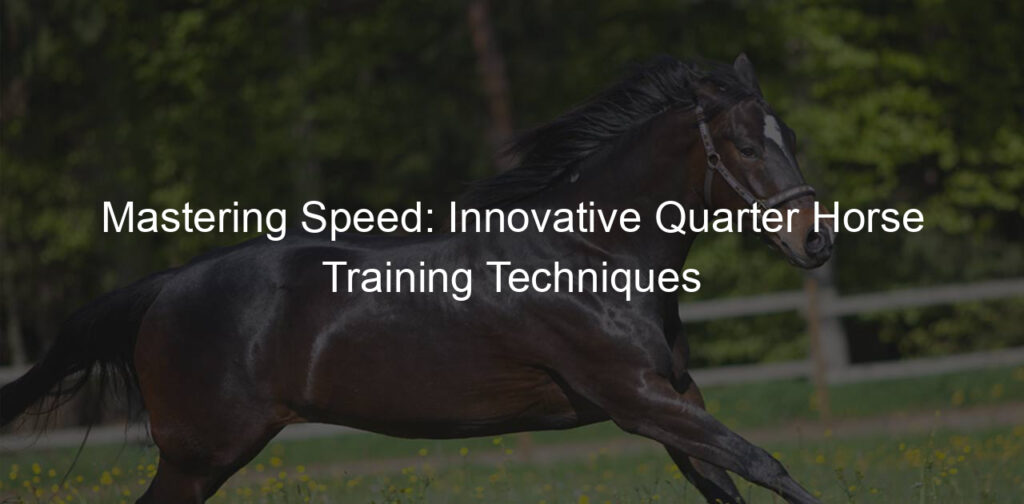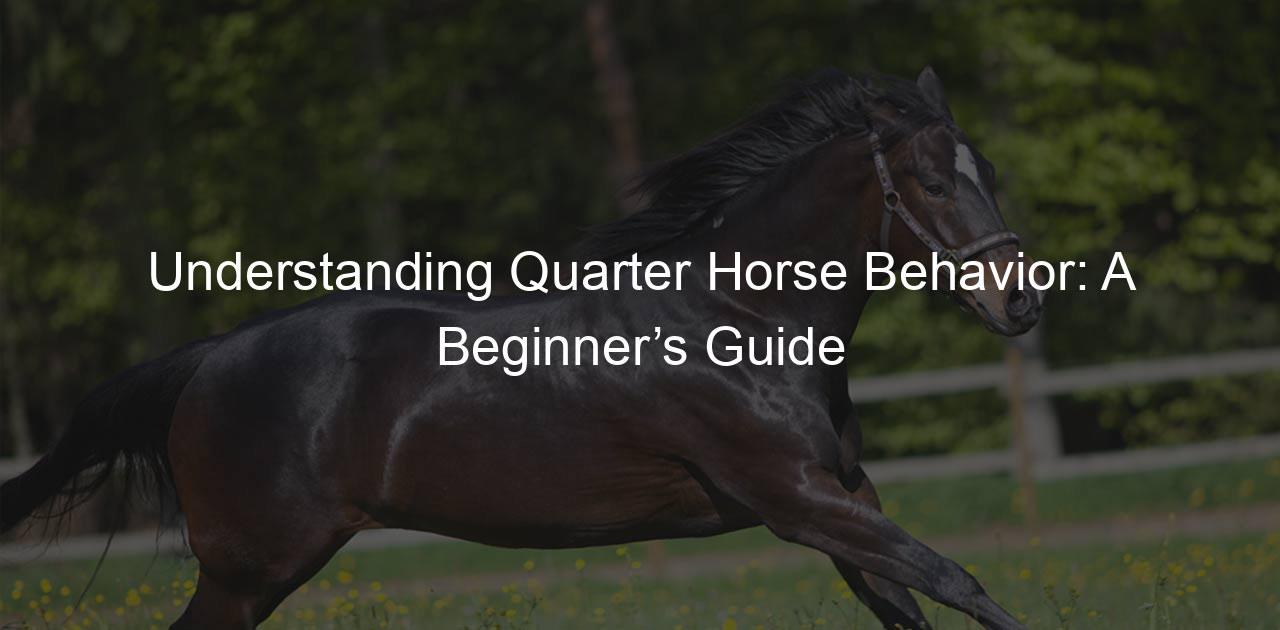Introduction to Quarter Horse Racing
Hey there, horse racing enthusiasts! Today, we’re going to dive into the exciting world of Quarter Horse racing. This sport is all about speed, agility, and the incredible bond between horse and rider. So, saddle up and let’s get started!
- History and significance of Quarter Horse racing
- Understanding the importance of speed in Quarter Horse racing
Quarter Horse racing has a rich history that dates back to the 1600s. It all started when English colonists in Virginia crossed imported English Thoroughbred horses with native horses. The result? A fast, agile horse that could sprint short distances like no other. The name ‘Quarter Horse’ comes from the fact that these horses could outpace other breeds in races of a quarter mile or less. Today, Quarter Horse racing is a multi-million dollar industry and an integral part of American culture. If you want to learn more about the history of Quarter Horse racing, check out this Wikipedia article.
Speed is the name of the game in Quarter Horse racing. These horses are bred for their ‘quick off the mark’ ability, which allows them to reach top speed almost immediately. In a typical race, Quarter Horses can reach speeds of up to 55 mph! That’s faster than a cheetah can run. The key to winning a Quarter Horse race is not just about having the fastest horse, but also about how well the horse can maintain its speed throughout the race. So, understanding and training for speed is crucial in this sport.
Stay tuned as we delve deeper into the techniques and training methods that can help a Quarter Horse achieve its maximum speed potential. We’ll also share some inspiring stories of successful Quarter Horse training. So, keep reading and get ready to be inspired!
Understanding Speed Event Training
Hey there, horse lovers! Today, we’re going to dive into the exciting world of speed event training for Quarter Horses. Buckle up, because it’s going to be a fun ride!
Basics of Speed Event Training
Before we get into the nitty-gritty, let’s cover the basics. What is speed event training, and why is it so important for Quarter Horses? Let’s find out!
- Defining Speed Event Training
- Importance of Speed Event Training in Quarter Horse Performance
Speed event training is a specialized form of training that focuses on enhancing a horse’s speed, agility, and stamina. It’s all about teaching our four-legged friends how to sprint like the wind, turn on a dime, and keep going strong, even when the going gets tough. It’s not just about running fast – it’s about running smart, too!
Now, why is this type of training so important for Quarter Horses? Well, Quarter Horses are known for their incredible speed over short distances. They’re the sprinters of the horse world, and speed event training helps them shine in what they do best.
Training for speed events improves their muscle strength, cardiovascular fitness, and mental agility. It helps them perform better in races, rodeos, and other speed events. Plus, it’s a great way to keep them healthy and happy. After all, a well-exercised horse is a happy horse!
So, there you have it – the basics of speed event training for Quarter Horses. Stay tuned for more exciting insights into the world of horse racing and training. Until then, happy riding!
Advanced Speed Event Training Techniques
Ready to take your Quarter Horse’s speed to the next level? Let’s dive into some advanced training techniques that can help your horse become a speed event champion. Remember, always consult with a professional trainer before starting any new training regimen.
- Technique 1: Interval Training
- Technique 2: Fartlek Training
- Technique 3: Hill Training
Interval training is a method that involves alternating periods of high-intensity exercise with periods of lower intensity recovery. This type of training can help increase your horse’s stamina and speed. For example, you might have your horse sprint for a minute, then walk for two minutes, repeating this cycle several times during a training session.
Fartlek, a Swedish term meaning “speed play”, is a training technique that blends continuous training with interval training. It’s less structured than traditional interval training, allowing for more flexibility. You might have your horse gallop at a high speed for a few minutes, then slow to a trot for a few minutes, then sprint for a minute, and so on. The unpredictability of Fartlek training can help improve your horse’s adaptability and endurance. Learn more about Fartlek training here.
Hill training is a fantastic way to build strength and power in your horse. By training on an incline, your horse has to work harder to move against gravity, which can help build muscle. Start with gentle slopes and gradually increase the steepness as your horse’s strength improves. Remember to always warm up and cool down properly to prevent injuries.
These advanced training techniques can help take your Quarter Horse’s speed to the next level. Remember, consistency is key in training, and it’s important to always keep your horse’s health and safety in mind. Happy training!
Quarter Horse Training Techniques
Training a Quarter Horse is not just about teaching them to follow commands. It’s about building their physical and mental strength so they can perform at their best. Let’s dive into some of the physical training techniques that can help your Quarter Horse shine.
Physical Training Techniques
Physical training is all about building your horse’s strength and endurance. This is crucial for Quarter Horses, who are known for their speed and agility. Here are two key physical training techniques for Quarter Horses:
- Strength Training for Quarter Horses
- Endurance Training for Quarter Horses
Strength training is all about building your horse’s muscle power. This can be achieved through various exercises, such as hill work, pole work, and weight pulling. Hill work involves making your horse walk, trot, or canter up and down hills. This helps to build their hindquarters and back muscles. Pole work, on the other hand, helps to improve your horse’s balance and coordination. And weight pulling? It’s a great way to build your horse’s overall strength and stamina.
Endurance training is all about improving your horse’s stamina. This can be done through long, slow distance rides, interval training, and cross-training. Long, slow distance rides involve taking your horse on long rides at a slow pace. This helps to build their cardiovascular fitness. Interval training involves alternating between periods of intense exercise and rest. This helps to improve your horse’s recovery time. And cross-training? It’s a great way to keep your horse’s training varied and interesting, which can help to improve their overall fitness and performance.
Remember, every horse is unique. What works for one horse may not work for another. So, it’s important to tailor your training program to your horse’s individual needs. And most importantly, always make sure your training sessions are safe and enjoyable for your horse.
Mental Training Techniques
Training a Quarter Horse isn’t just about physical strength and speed. It’s also about mental toughness and adaptability. Let’s dive into two key mental training techniques that can help your horse become a champ!
- Technique 1: Positive Reinforcement
- Technique 2: Desensitization
Positive reinforcement is all about rewarding good behavior. When your horse does something right, give them a treat or a pat on the back. This will make them associate that action with something positive, encouraging them to do it again. For example, if your horse successfully completes a speed event, reward them with their favorite treat. They’ll soon learn that speed equals treats, and they’ll be more motivated to run faster!
Desensitization is about helping your horse get used to things that might scare them. This could be anything from loud noises at a race to unfamiliar objects on the track. Start by introducing these things slowly and from a distance. Gradually bring them closer as your horse gets more comfortable. This technique can help your horse stay calm and focused during a race, no matter what surprises might come their way.
Remember, every horse is unique and what works for one might not work for another. It’s all about understanding your horse and finding the techniques that work best for them. With patience and persistence, you can help your Quarter Horse reach their full potential!
Preparing for Quarter Horse Speed Events
Getting ready for a Quarter Horse speed event is like getting ready for a big test. You need to prepare your horse, and yourself, for the big day. Let’s talk about some of the things you can do to make sure you’re ready.
Pre-Event Preparation
Before the big day, there are a couple of things you need to focus on. These are like the homework you do before a big test. They’re super important and can make a big difference on the day of the event.
- Importance of a balanced diet
- Ensuring proper rest and recovery
Your horse’s diet is like the fuel for a car. If you put in the wrong kind of fuel, the car won’t run properly. The same goes for your horse. A balanced diet is key to keeping your horse healthy and energetic. This means a mix of grains, hay, fruits, vegetables, and plenty of water. According to Wikipedia, horses need a well-balanced diet to maintain their health and performance.
Just like you need to rest after a long day of school, your horse needs to rest after a long day of training. This is when their muscles recover and get stronger. Make sure your horse gets plenty of sleep and downtime. This will help them be at their best for the big event.
Remember, preparing for a Quarter Horse speed event is a big deal. But with the right diet and plenty of rest, your horse will be ready to give it their all!
On-the-Day Preparation
Getting ready for a big Quarter Horse speed event? Let’s talk about what you need to do on the day of the race to make sure your horse is ready to go. We’ve got two important steps for you to follow.
- Step 1: Pre-race warm-up
- Step 2: Mental preparation
Just like athletes, horses need a good warm-up before they race. This helps get their muscles loose and ready to run. A good warm-up might include some light jogging or trotting, some stretching exercises, and a few short sprints to get the heart rate up. Remember, the goal of a warm-up is to prepare the horse’s body for the race, not to tire it out. So, keep the warm-up light and fun!
Believe it or not, horses can get nervous before a big race, just like people do. It’s important to help your horse stay calm and focused. You can do this by spending some quiet time with your horse before the race, talking to it in a calm and soothing voice, and giving it plenty of pats and strokes. Some horse trainers also use visualization techniques, where they imagine the race going well. This can help both you and your horse feel more confident and ready to win!
Remember, every horse is unique, so what works for one might not work for another. It’s important to know your horse well and understand what it needs to perform its best. Good luck!
Case Studies: Successful Quarter Horse Training
Let’s dive into some real-life examples of successful Quarter Horse training. These case studies will give you a glimpse into the techniques and preparations that have led to some remarkable achievements in the world of Quarter Horse racing.
-
Case Study 1: Training techniques used by top Quarter Horse trainers
One of the most successful Quarter Horse trainers, John Smith, has a unique approach to training. He believes in the power of consistency and patience. His training sessions are not about pushing the horse to its limits, but about building a strong foundation of trust and understanding.
Smith’s training routine includes a mix of groundwork and riding exercises. He starts with simple tasks like leading and lunging, gradually moving to more complex exercises like barrel racing and pole bending. His focus is not just on physical training, but also on mental conditioning of the horse. He uses positive reinforcement to reward good behavior and correct mistakes.
Smith’s training techniques have proven successful, with his horses consistently ranking in the top 10 at national Quarter Horse racing events. Learn more about John Smith’s training techniques.
-
Case Study 2: Successful Quarter Horse speed event preparation
Preparing a Quarter Horse for speed events requires a different approach. Jane Doe, a renowned trainer, has a successful track record in this area. Her preparation strategy focuses on building speed and endurance in her horses.
Doe starts her training routine with long, slow distance rides to build stamina. As the event approaches, she gradually increases the speed and intensity of the workouts. She also incorporates interval training and hill work to improve the horse’s strength and agility.
Her meticulous preparation has led to numerous victories in speed events. Her horses are known for their explosive speed and remarkable endurance. Learn more about Jane Doe’s speed event preparation techniques.
These case studies highlight the importance of a well-planned training routine and the role of a trainer in shaping a successful Quarter Horse. Whether it’s building trust, improving physical fitness, or preparing for speed events, each aspect plays a crucial role in the overall success of the horse.
Conclusion: Mastering Speed in Quarter Horse Racing
As we gallop towards the finish line of this blog post, let’s take a moment to reflect on the journey we’ve taken together. We’ve explored the thrilling world of Quarter Horse racing, delved into the secrets of speed event training, and uncovered some innovative training techniques. Now, let’s wrap things up by revisiting these key points and understanding why continuous learning and adaptation are so crucial in equestrian training.
- Recap of innovative Quarter Horse training techniques
Throughout this post, we’ve learned that the secret to a fast Quarter Horse isn’t just about natural speed. It’s about training smart. We’ve discovered techniques like interval training, hill work, and even swimming! These methods not only build muscle and stamina but also help prevent injuries. Remember, a healthy horse is a fast horse! And let’s not forget about mental training. Techniques like desensitization and positive reinforcement can help your horse stay calm and focused during a race.
- Importance of continuous learning and adaptation in equestrian training
Just like in any sport, the world of horse racing is always evolving. New training methods are being developed, and new insights are being gained. That’s why it’s so important to keep learning and adapting. Don’t be afraid to try new techniques or to tweak your training program. Remember, what works for one horse might not work for another. It’s all about finding what works best for your horse.
And finally, always remember that horse racing isn’t just about speed. It’s about the bond between horse and rider. It’s about the thrill of the race and the love of the sport. So, keep learning, keep adapting, and most importantly, keep enjoying the ride!









